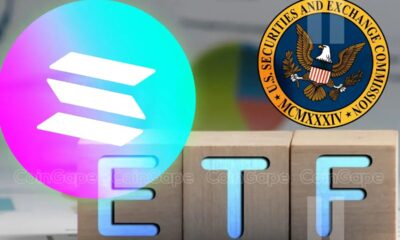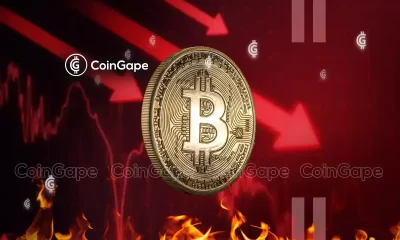cryptocurrency
Worldcoin remains unfazed by whale selloff, rises 17% in 24 hours
Published
3 months agoon
By
admin
Worldcoin witnessed a strong whale selloff yesterday, Sept. 25, but the asset still continued its upward momentum.
Worldcoin (WLD) is up by 17.3% in the past 24 hours and is trading at $2.12 at the time of writing. The asset’s market cap surpassed the $1 billion market again, making it the 69th-largest digital currency.
WLD’s daily trading volume also recorded an 85% rally, reaching $430 million.
According to data provided by IntoTheBlock, large Worldcoin holders recorded 6.23 million WLD — worth $13.15 million — in outflows on Sept. 25. The indicator shows that the number of whales selling the asset was much greater than the ones accumulating.

Whale selloffs usually hint at times of panic or profit-taking, both of which lead to price declines. At this point, WLD has recorded a 32% price surge over the past week, remaining unfazed by the large whale selloff.
Per a crypto.news report on Aug. 21, Worldcoin’s 40% plunge below the $1.4 mark put over 92% of its holders at a loss.
Data from ITB shows that the number of WLD holders suffering losses has declined to 68% at the reporting time.
One of the bullish drivers for the WLD price was the recent announcement from the company. Worldcoin revealed that it launched World ID in three more countries — Guatemala, Malaysia, and Poland.
It’s important to note that price hikes on the back of big announcements have shown to be short-lived. If the whale selloff continues, a price correction would be expected for the WLD price.
Source link
You may like


Stablecoin Issuer Tether Invests $775,000,000 Into YouTube Rival Rumble


Solana L2 Sonic includes TikTok users in airdrop


5 Tokens Ready For A 20X After Solana ETF Approval


Solana beats Ethereum in a key metric 3 months in a row


SCENE’s 2024 Person of the Year: Iggy Azalea


BTC Risks Falling To $20K If This Happens
Bitcoin
Metaplanet makes largest Bitcoin bet, acquires nearly 620 BTC
Published
13 hours agoon
December 23, 2024By
admin

Tokyo-listed Metaplanet has purchased another 9.5 billion yen ($60.6 million) worth of Bitcoin, pushing its holdings to 1,761.98 BTC.
Metaplanet, a publicly traded Japanese company, has acquired 619.7 Bitcoin as part of its crypto treasury strategy, paying an average of 15,330,073 yen per (BTC), with a total investment of 9.5 billion yen.
According to the company’s latest financial disclosure, Metaplanet’s total Bitcoin holdings now stand at 1,761.98 BTC, with an average purchase price of 11,846,002 yen (~$75,628) per Bitcoin. The company has spent 20.872 billion yen in total on Bitcoin acquisitions, the document reads.
The latest purchase is the largest so far for the Tokyo-headquartered company and comes just days after Metaplanet issued its 5th Series of Ordinary Bonds via private placement with EVO FUND, raising 5 billion yen (approximately $32 million).
The proceeds from this issuance, as disclosed earlier, were allocated specifically for purchasing Bitcoin. These bonds, set to mature in June 2025, carry no interest and allow for early redemption under specific conditions.
Metaplanet buys dip
The company also shared updates on its BTC Yield, a metric used to measure the growth of Bitcoin holdings relative to fully diluted shares. From Oct. 1 to Dec. 23, Metaplanet’s BTC Yield surged to 309.82%, up from 41.7% in the previous quarter.
Bitcoin itself has seen strong performance this year, climbing 120% and outperforming assets like the Nasdaq 100 and S&P 500 indices. However, it has recently pulled back from its all-time high of $108,427, trading at $97,000 after the Federal Reserve indicated only two interest rate cuts in 2025.
Despite the retreat, on-chain metrics indicate that Bitcoin is still undervalued based on its Market Value to Realized Value (MVRV-Z) score, which stands at 2.84 — below the threshold of 3.7 that historically signals an asset is overvalued.
Source link
Blockchain
Horizen spikes 60% to lead gainers as BTC, ETH bounce
Published
3 days agoon
December 20, 2024By
admin

Horizen price spiked more than 60% in 24 hours as the cryptocurrency market looked to recover from a massive dump that saw top altcoins crash to key support levels.
On Dec. 20, as Bitcoin (BTC) traded to above $97k and Ethereum (ETH) bulls pushed above $3,400, the price of Horizen (ZEN) surged to highs of $26.34. The cryptocurrency, which rallied sharply following a recent Grayscale Investments announcement, reached a multi-year high and ranked among the top gainers in the 500 largest cryptocurrencies by market cap.
ZEN traded at lows of $14.55 on Dec. 19. However, despite the broader crypto crash and the staggering $1.4 billion liquidations, the altcoin’s price hovered above $26 in early trading during the U.S. trading session.
According to crypto.news price data, Horizen recorded a 24-hour trading volume of over $397 million, with its market cap exceeding $407 million. These metrics reflected increases of 294% and 62%, respectively, in the past 24 hours. While ZEN has surged nearly 200% over the past month, its current levels are still more than 84% below the all-time high of $168 reached in May 2021.
If the broader crypto market continues to rebound, ZEN bulls may aim for March 2022 highs near $50.
The positive momentum has benefited from Grayscale opening of the Grayscale ZEN Trust to qualified investors. Prices of the altcoin rose as the digital asset manager unveiled the fund to offer exposure to Horizen for qualified investors.
Earlier this month, Horizen’s native token underwent its final halving, which came as the project geared for a key change in its tokenomics. ZEN will not see any further halvings as the new network mechanism enables a declining emission rate.
That’s because Horizen, is shifting from the proof of work mining model that mirrored Bitcoin’s halving cycle to a new proof of stake mechanism in 2025. Horizen’s last halving occurred on Dec. 12, 2024.
New tokenomics for Horizen will come into effect in the first half of 2025.
Source link
Binance
Binance Futures updates leverage and margin tiers for multiple USDⓈ-M perpetual contracts
Published
4 days agoon
December 19, 2024By
admin

Binance’s updated leverage and margin tiers offer improved trading options for select trading pairs, bringing both potential rewards and risks for crypto traders.
The leverage and margin levels for USDⓈ-M perpetual contracts, including DAR, ME, CAKE, IOTA, LPT, ONE, and ZEN, will be updated by Binance Futures today, with effect from 08:15 UTC on Dec. 19, 2024.
USDⓈ-M stands for USD-Margined Futures, a type of cryptocurrency futures contract offered on platforms like Binance. It refers to stablecoins such as USDT (Tether) or BUSD (BUSD), which are pegged to the US dollar. These contracts are settled in these stablecoins, rather than traditional fiat currency or the underlying crypto asset.
Depending on the contract and position size, the revised leverage tiers will vary from 1x to 75x, enabling traders to fully benefit from their leveraged positions in the crypto market.
Leveraged positions of traders will be impacted by the new maintenance margin rates, which range from 1.00% to 50.00%.
Margin is the total amount of collateral needed to open and sustain a trading position, whereas leverage is the borrowing of funds to increase the size of a position. The possible return increases with leverage, but the chance of loss also goes up.
By adjusting the margin and leverage tiers, Binance Futures continues to give traders more choices to control risk and profit from volatile crypto market movements.
Traders must keep themselves updated with Binance Future trading rules and exercise risk management, particularly when working with high-leverage instruments over several contracts and margin holdings.
Source link

Stablecoin Issuer Tether Invests $775,000,000 Into YouTube Rival Rumble

Solana L2 Sonic includes TikTok users in airdrop

5 Tokens Ready For A 20X After Solana ETF Approval

Solana beats Ethereum in a key metric 3 months in a row

SCENE’s 2024 Person of the Year: Iggy Azalea

BTC Risks Falling To $20K If This Happens

Most Layer 2 solutions are still struggling with scalability

Here’s why Stellar Price Could Go Parabolic Soon

Perp-Focused HyperLiquid Experiences Record $60M in USDC Net Outflows

Experts say these 3 altcoins will rally 3,000% soon, and XRP isn’t one of them

Robert Kiyosaki Hints At Economic Depression Ahead, What It Means For BTC?

BNB Steadies Above Support: Will Bullish Momentum Return?

Metaplanet makes largest Bitcoin bet, acquires nearly 620 BTC

Tron’s Justin Sun Offloads 50% ETH Holdings, Ethereum Price Crash Imminent?

Investors bet on this $0.0013 token destined to leave Cardano and Shiba Inu behind
182267361726451435

Why Did Trump Change His Mind on Bitcoin?

Top Crypto News Headlines of The Week

New U.S. president must bring clarity to crypto regulation, analyst says

Will XRP Price Defend $0.5 Support If SEC Decides to Appeal?

Bitcoin Open-Source Development Takes The Stage In Nashville

Ethereum, Solana touch key levels as Bitcoin spikes

Bitcoin 20% Surge In 3 Weeks Teases Record-Breaking Potential

Ethereum Crash A Buying Opportunity? This Whale Thinks So

Shiba Inu Price Slips 4% as 3500% Burn Rate Surge Fails to Halt Correction

Washington financial watchdog warns of scam involving fake crypto ‘professors’

‘Hamster Kombat’ Airdrop Delayed as Pre-Market Trading for Telegram Game Expands

Citigroup Executive Steps Down To Explore Crypto
Mostbet Güvenilir Mi – Casino Bonus 2024

NoOnes Bitcoin Philosophy: Everyone Eats
Trending

 3 months ago
3 months ago182267361726451435

 Donald Trump5 months ago
Donald Trump5 months agoWhy Did Trump Change His Mind on Bitcoin?

 24/7 Cryptocurrency News4 months ago
24/7 Cryptocurrency News4 months agoTop Crypto News Headlines of The Week

 News4 months ago
News4 months agoNew U.S. president must bring clarity to crypto regulation, analyst says

 Price analysis4 months ago
Price analysis4 months agoWill XRP Price Defend $0.5 Support If SEC Decides to Appeal?

 Opinion5 months ago
Opinion5 months agoBitcoin Open-Source Development Takes The Stage In Nashville

 Bitcoin5 months ago
Bitcoin5 months agoEthereum, Solana touch key levels as Bitcoin spikes

 Bitcoin5 months ago
Bitcoin5 months agoBitcoin 20% Surge In 3 Weeks Teases Record-Breaking Potential


